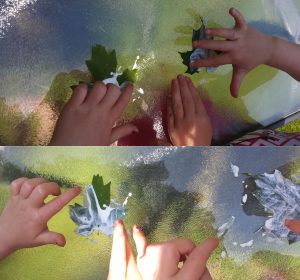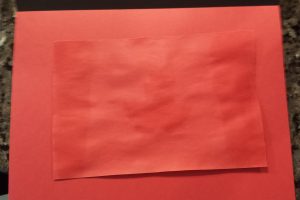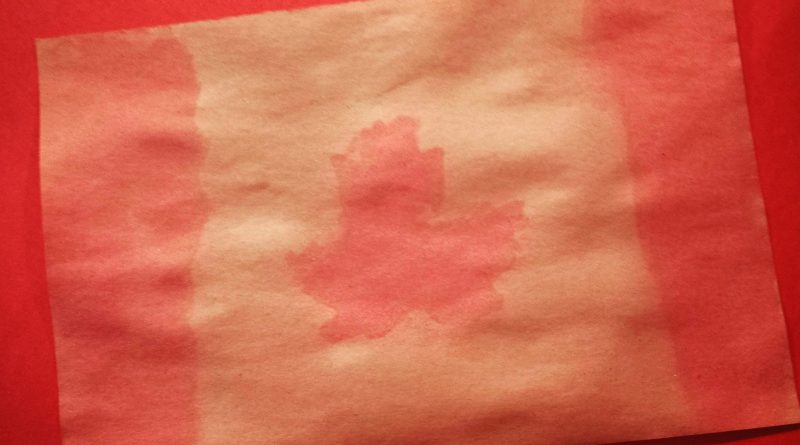Sunscreen, eh
We celebrated this Canada Day with a crafty experiment that also taught the kids a VERY important lesson. The power of the sun’s rays and how we need to protect ourselves from them. This time of year the time we spend outdoors is at an all time high, and so is the UV index! We have traded our snowsuits for swimsuits and added sunscreen!
Because it was Canada Day, we decided to test the protecting power of sunscreen while creating our own Canadian Flag (but really, you could create whatever you like!).
Let’s Experiment!
This STEM mama also tried her hand at creating a how-to YouTube Video. Check it out! (But you can also learn how with our step-by-step instructions below too!) Be sure to read about the science behind this art-experiment at the bottom of this post!
What you need:
- Red construction paper
- Sunscreen
- Maple leaf
- Sun
The Setup:
- Pick your construction paper, the darker the better. We choose red because we were making a Canadian Flag.

Red construction paper. - Spread some sunscreen on the parts of the construction paper that you want to stay dark. For the Canadian Flag “paint” a rectangle on each end of the paper.

Applying the sunscreen. - Find a maple leaf (a perfect time to get the kids to explore and use their identification skills to find the correct tree!).
- Spread some sunscreen on the maple leaf.

Spread the sunscreen on the maple leaf. - Carefully press the sunscreen covered side of the leaf onto the middle of the construction paper. Then carefully remove the leaf.

Press the side of the maple leaf with the sunscreen firmly onto the paper and carefully peel off. - Place the “flag” in a sunny spot. It may take a full day (or two) of full sun to fade the unprotected parts of the paper.

A nice sunny day. Perfect for paper bleaching. - Check out your flag after it has been out in the sun. Compare it to a fresh piece of red construction paper. Has it faded?

Our flags after being out in the sun. Compared to a fresh piece of red construction paper. - Take a close look at your sun-bleached paper. Did the sunscreen protect the paper from the sun?

Comparing the red paper before and after. - Flip it over. The side NOT exposed to the sun should still be very red!

Side NOT exposed to sunlight.
What else could you do?
- Test how the sun affects different types and colours of paper.
- Make a fun picture using different sunscreens with different ingredients and/or SPF.
- Compare the paper exposed to the sun on a cloudy or a sunny day.
- Monitor how “fast” the paper fades. Keep a log!
What’s going on?
Sunlight contains ultraviolet (UV) light. Our eyes cannot see UV light, but it’s there and it has lots of energy. In fact, the UV light is so powerful that it can damage our DNA. What is DNA? It’s the stuff in living things that decides how that living thing looks and works (it’s pretty important!). We all know that if you stay out too long in the hot sun we may end up with a nasty sunburn. We have damaged our skin (and some of our DNA!). If we keep damaging our DNA, we may increase our chances of developing skin cancer.
Preparing for a day outside in the summer will often involve applying sunscreen. We do this to prevent a painful sunburn. But how does sunscreen work?
You may have noticed the label of the sunscreen bottle says something called SPF with a number afterwards, for example, SPF30. SPF stands for Sun Protection Factor. SPF10 only lets 10% of the sun’s light rays reach our skin. SPF20 only lets 5% reach our skin. Some sunlight will still reach your skin, even with sunscreen on, so you never protected indefinitely and it’s protective properties can wear off over time. So you do need to reapply! But basically, sunscreen blocks those dangerous UV rays from reaching your skin!
Find the ingredient list on the sunscreen bottle. You may see things like zinc oxide or titanium oxide. These chemicals either reflect or scatter UV radiation (think of it like the UV light hits the sunscreen and then bounces off and away from you). You may see chemicals in the ingredient list like octyl methoxycinnamate (OMC) or oxybenzone. These ones absorb UV light, again keeping them away from our skin (think of it like a kid wearing a diaper sitting on the couch, all the pee (UV light) is absorbed into the diaper so the couch (your skin) never gets wet (damaged by the sun!)).
In our paper experiment. When the paper is exposed to sunlight, the paper will fade as the UV light starts to bleach/damage the paper. So over time, the paper gets lighter, and lighter in colour. The parts of the paper that we applied the sunscreen, will still fade (because sunscreen isn’t perfect) but it doesn’t happen nearly as fast! So you get to play out in the sun longer before you risk a sunburn.
The lesson here is that sunscreen helps to protect you from the harmful rays of the sun! Now put on your sunscreen and get outside and enjoy summer!

